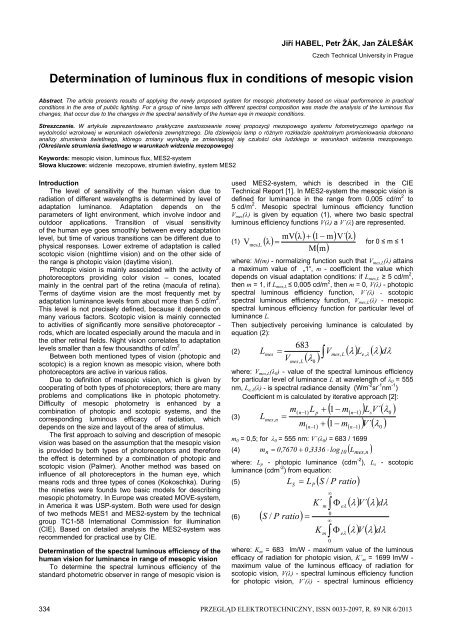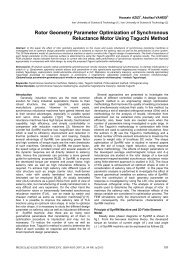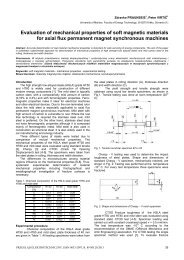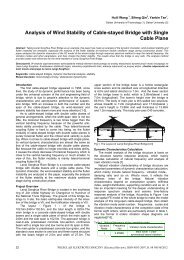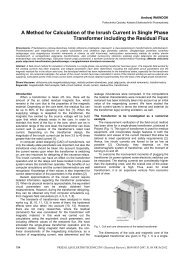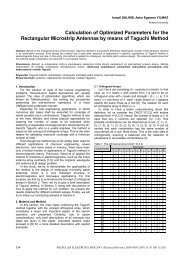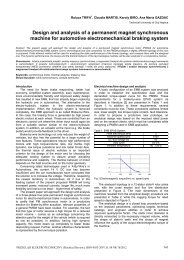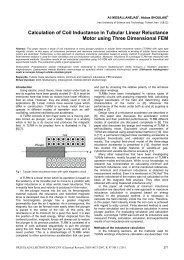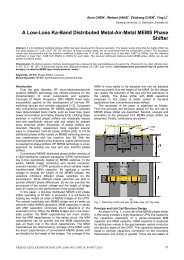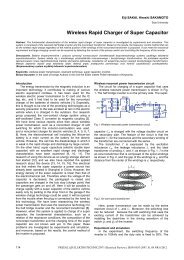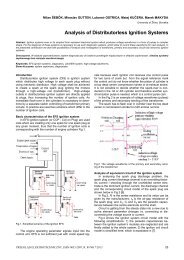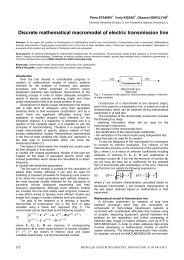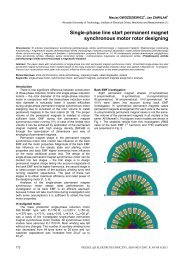Determination of luminous flux in conditions of mesopic vision
Determination of luminous flux in conditions of mesopic vision
Determination of luminous flux in conditions of mesopic vision
You also want an ePaper? Increase the reach of your titles
YUMPU automatically turns print PDFs into web optimized ePapers that Google loves.
Jiří HABEL, Petr ŽÁK, Jan ZÁLEŠÁK<br />
Czech Technical University <strong>in</strong> Prague<br />
<strong>Determ<strong>in</strong>ation</strong> <strong>of</strong> <strong>lum<strong>in</strong>ous</strong> <strong>flux</strong> <strong>in</strong> <strong>conditions</strong> <strong>of</strong> <strong>mesopic</strong> <strong>vision</strong><br />
Abstract. The article presents results <strong>of</strong> apply<strong>in</strong>g the newly proposed system for <strong>mesopic</strong> photometry based on visual performance <strong>in</strong> practical<br />
<strong>conditions</strong> <strong>in</strong> the area <strong>of</strong> public light<strong>in</strong>g. For a group <strong>of</strong> n<strong>in</strong>e lamps with different spectral composition was made the analysis <strong>of</strong> the <strong>lum<strong>in</strong>ous</strong> <strong>flux</strong><br />
changes, that occur due to the changes <strong>in</strong> the spectral sensitivity <strong>of</strong> the human eye <strong>in</strong> <strong>mesopic</strong> <strong>conditions</strong>.<br />
Streszczenie. W artykule zaprezentowano praktyczne zastosowanie nowej propozycji mezopowego systemu fotometrycznego opartego na<br />
wydolności wzrokowej w warunkach oświetlenia zewnętrznego. Dla dziewięciu lamp o różnym rozkładzie spektralnym promieniowania dokonano<br />
analizy strumienia świetlnego, którego zmiany wynikają ze zmieniającej się czułości oka ludzkiego w warunkach widzenia mezopowego.<br />
(Określanie strumienia świetlnego w warunkach widzenia mezopowego)<br />
Keywords: <strong>mesopic</strong> <strong>vision</strong>, <strong>lum<strong>in</strong>ous</strong> <strong>flux</strong>, MES2-system<br />
Słowa kluczowe: widzenie mezopowe, strumień świetlny, system MES2<br />
Introduction<br />
The level <strong>of</strong> sensitivity <strong>of</strong> the human <strong>vision</strong> due to<br />
radiation <strong>of</strong> different wavelengths is determ<strong>in</strong>ed by level <strong>of</strong><br />
adaptation lum<strong>in</strong>ance. Adaptation depends on the<br />
parameters <strong>of</strong> light environment, which <strong>in</strong>volve <strong>in</strong>door and<br />
outdoor applications. Transition <strong>of</strong> visual sensitivity<br />
<strong>of</strong> the human eye goes smoothly between every adaptation<br />
level, but time <strong>of</strong> various transitions can be different due to<br />
physical responses. Lower extreme <strong>of</strong> adaptation is called<br />
scotopic <strong>vision</strong> (nighttime <strong>vision</strong>) and on the other side <strong>of</strong><br />
the range is photopic <strong>vision</strong> (daytime <strong>vision</strong>).<br />
Photopic <strong>vision</strong> is ma<strong>in</strong>ly associated with the activity <strong>of</strong><br />
photoreceptors provid<strong>in</strong>g color <strong>vision</strong> – cones, located<br />
ma<strong>in</strong>ly <strong>in</strong> the central part <strong>of</strong> the ret<strong>in</strong>a (macula <strong>of</strong> ret<strong>in</strong>a).<br />
Terms <strong>of</strong> daytime <strong>vision</strong> are the most frequently met by<br />
adaptation lum<strong>in</strong>ance levels from about more than 5 cd/m 2 .<br />
This level is not precisely def<strong>in</strong>ed, because it depends on<br />
many various factors. Scotopic <strong>vision</strong> is ma<strong>in</strong>ly connected<br />
to activities <strong>of</strong> significantly more sensitive photoreceptor -<br />
rods, which are located especially around the macula and <strong>in</strong><br />
the other ret<strong>in</strong>al fields. Night <strong>vision</strong> correlates to adaptation<br />
levels smaller than a few thousandths <strong>of</strong> cd/m 2 .<br />
Between both mentioned types <strong>of</strong> <strong>vision</strong> (photopic and<br />
scotopic) is a region known as <strong>mesopic</strong> <strong>vision</strong>, where both<br />
photoreceptors are active <strong>in</strong> various ratios.<br />
Due to def<strong>in</strong>ition <strong>of</strong> <strong>mesopic</strong> <strong>vision</strong>, which is given by<br />
cooperat<strong>in</strong>g <strong>of</strong> both types <strong>of</strong> photoreceptors; there are many<br />
problems and complications like <strong>in</strong> photopic photometry.<br />
Difficulty <strong>of</strong> <strong>mesopic</strong> photometry is enhanced by a<br />
comb<strong>in</strong>ation <strong>of</strong> photopic and scotopic systems, and the<br />
correspond<strong>in</strong>g <strong>lum<strong>in</strong>ous</strong> efficacy <strong>of</strong> radiation, which<br />
depends on the size and layout <strong>of</strong> the area <strong>of</strong> stimulus.<br />
The first approach to solv<strong>in</strong>g and description <strong>of</strong> <strong>mesopic</strong><br />
<strong>vision</strong> was based on the assumption that the <strong>mesopic</strong> <strong>vision</strong><br />
is provided by both types <strong>of</strong> photoreceptors and therefore<br />
the effect is determ<strong>in</strong>ed by a comb<strong>in</strong>ation <strong>of</strong> photopic and<br />
scotopic <strong>vision</strong> (Palmer). Another method was based on<br />
<strong>in</strong>fluence <strong>of</strong> all photoreceptors <strong>in</strong> the human eye, which<br />
means rods and three types <strong>of</strong> cones (Kokoschka). Dur<strong>in</strong>g<br />
the n<strong>in</strong>eties were founds two basic models for describ<strong>in</strong>g<br />
<strong>mesopic</strong> photometry. In Europe was created MOVE-system,<br />
<strong>in</strong> America it was USP-system. Both were used for design<br />
<strong>of</strong> two methods MES1 and MES2-system by the technical<br />
group TC1-58 International Commission for illum<strong>in</strong>ation<br />
(CIE). Based on detailed analysis the MES2-system was<br />
recommended for practical use by CIE.<br />
<strong>Determ<strong>in</strong>ation</strong> <strong>of</strong> the spectral <strong>lum<strong>in</strong>ous</strong> efficiency <strong>of</strong> the<br />
human <strong>vision</strong> for lum<strong>in</strong>ance <strong>in</strong> range <strong>of</strong> <strong>mesopic</strong> <strong>vision</strong><br />
To determ<strong>in</strong>e the spectral <strong>lum<strong>in</strong>ous</strong> efficiency <strong>of</strong> the<br />
standard photometric observer <strong>in</strong> range <strong>of</strong> <strong>mesopic</strong> <strong>vision</strong> is<br />
used MES2-system, which is described <strong>in</strong> the CIE<br />
Technical Report [1]. In MES2-system the <strong>mesopic</strong> <strong>vision</strong> is<br />
def<strong>in</strong>ed for lum<strong>in</strong>ance <strong>in</strong> the range from 0,005 cd/m 2 to<br />
5 cd/m 2 . Mesopic spectral <strong>lum<strong>in</strong>ous</strong> efficiency function<br />
V mes (λ) is given by equation (1), where two basic spectral<br />
<strong>lum<strong>in</strong>ous</strong> efficiency functions V(λ) a V´(λ) are represented.<br />
(1) V λ<br />
mes, L<br />
mV λ<br />
1<br />
mV´<br />
λ<br />
Mm<br />
for 0 ≤ m ≤ 1<br />
where: M(m) - normaliz<strong>in</strong>g function such that V mes,L (λ) atta<strong>in</strong>s<br />
a maximum value <strong>of</strong> „1“, m - coefficient the value which<br />
depends on visual adaptation <strong>conditions</strong>: if L mes,L ≥ 5 cd/m 2 ,<br />
then m = 1, if L mes,L ≤ 0,005 cd/m 2 , then m = 0, V(λ) - photopic<br />
spectral <strong>lum<strong>in</strong>ous</strong> efficiency function, V´(λ) - scotopic<br />
spectral <strong>lum<strong>in</strong>ous</strong> efficiency function, V mes,L (λ) - <strong>mesopic</strong><br />
spectral <strong>lum<strong>in</strong>ous</strong> efficiency function for particular level <strong>of</strong><br />
lum<strong>in</strong>ance L.<br />
Then subjectively perceiv<strong>in</strong>g lum<strong>in</strong>ance is calculated by<br />
equation (2):<br />
(2)<br />
L<br />
<br />
683<br />
<br />
<br />
<br />
V<br />
<br />
<br />
mes mes,<br />
L e,<br />
<br />
Vmes,<br />
L 0<br />
<br />
L<br />
<br />
d<br />
where: V mes,L (λ 0 ) - value <strong>of</strong> the spectral <strong>lum<strong>in</strong>ous</strong> efficiency<br />
for particular level <strong>of</strong> lum<strong>in</strong>ance L at wavelength <strong>of</strong> λ 0 = 555<br />
nm, L e, (λ) - is spectral radiance density (Wm -2 sr -1 nm -1 )<br />
Coefficient m is calculated by iterative approach [2]:<br />
(3)<br />
L<br />
mes,<br />
n<br />
m<br />
<br />
m<br />
( n1)<br />
L<br />
p<br />
<br />
<br />
1<br />
mn<br />
1LsV<br />
´ 0<br />
<br />
1<br />
m V<br />
´ <br />
<br />
n1 n1<br />
m 0 = 0,5; for λ 0 = 555 nm: V´(λ 0 ) = 683 / 1699<br />
(4) m 0, 7670 0,3336 log L<br />
<br />
n<br />
10<br />
mes,n<br />
where: L p - photopic lum<strong>in</strong>ance (cdm -2 ), L s - scotopic<br />
lum<strong>in</strong>ance (cdm -2 ) from equation:<br />
(5) L L S<br />
P ratio<br />
(6) S<br />
/ P ratio<br />
S P<br />
/<br />
<br />
K´<br />
K<br />
<br />
<br />
m<br />
0<br />
<br />
<br />
m<br />
0<br />
<br />
<br />
e<br />
e<br />
<br />
<br />
V´<br />
<br />
<br />
<br />
V<br />
<br />
<br />
0<br />
d<br />
d<br />
where: K m = 683 lm/W - maximum value <strong>of</strong> the <strong>lum<strong>in</strong>ous</strong><br />
efficacy <strong>of</strong> radiation for photopic <strong>vision</strong>, K´m = 1699 lm/W -<br />
maximum value <strong>of</strong> the <strong>lum<strong>in</strong>ous</strong> efficacy <strong>of</strong> radiation for<br />
scotopic <strong>vision</strong>, V(λ) - spectral <strong>lum<strong>in</strong>ous</strong> efficiency function<br />
for photopic <strong>vision</strong>, V´(λ) - spectral <strong>lum<strong>in</strong>ous</strong> efficiency<br />
334 PRZEGLĄD ELEKTROTECHNICZNY, ISSN 0033-2097, R. 89 NR 6/2013
function for scotopic <strong>vision</strong>, e () - spectral density <strong>of</strong><br />
compound radiant <strong>flux</strong> Φ e (λ).<br />
If the e () describes spectral composition <strong>of</strong> the radiant<br />
<strong>flux</strong>, then the e () is calculated from equation:<br />
(7) <br />
<br />
d<br />
<br />
<br />
<br />
e<br />
e <br />
d<br />
<br />
This methodology was used for calculation spectral<br />
<strong>lum<strong>in</strong>ous</strong> efficiency functions <strong>of</strong> human <strong>vision</strong> <strong>in</strong> range <strong>of</strong><br />
<strong>mesopic</strong> <strong>vision</strong> for determ<strong>in</strong>ation V´´() <strong>of</strong> particular<br />
selected values <strong>of</strong> <strong>mesopic</strong> lum<strong>in</strong>ance. These functions<br />
together with V´() and V() are displayed <strong>in</strong> figure 1.<br />
spectral <strong>lum<strong>in</strong>ous</strong> efficiency (-)<br />
1<br />
0.9<br />
0.8<br />
0.7<br />
0.6<br />
0.5<br />
0.4<br />
0.3<br />
0.2<br />
0.1<br />
0<br />
350 450 550 650 750<br />
wavelength (nm)<br />
<br />
<br />
<br />
Poměrná spekt. citlivost pro<br />
La < 0,005 cd/m 2<br />
skotopické vidění<br />
La = 0,01 cd/m 2<br />
Poměrná spekt. citlivost pro adap.<br />
jas 0,01 cd/m2<br />
Poměrná spekt. citlivost pro adap.<br />
La = 0,05 cd/m 2<br />
jas 0,05 cd/m2<br />
Poměrná spekt. citlivost pro adap.<br />
La = 0,1 cd/m 2<br />
jas 0,1 cd/m2<br />
Poměrná spekt. citlivost pro adap.<br />
La = 0,3 cd/m 2<br />
jas 0,3 cd/m2<br />
Poměrná spekt. citlivost pro adap.<br />
La = 0,5 cd/m 2<br />
jas 0,5 cd/m2<br />
Poměrná spekt. citlivost pro adap.<br />
La = 1 cd/m 2<br />
jas 1 cd/m2<br />
Poměrná<br />
La = 3<br />
spekt.<br />
cd/m<br />
citlivost 2 pro adap.<br />
jas 3 cd/m2<br />
Poměrná<br />
La > 5<br />
spekt.<br />
cd/m<br />
citlivost 2 pro<br />
fotopické vidění<br />
Fig. 1 Spectral <strong>lum<strong>in</strong>ous</strong> efficiency functions for selected<br />
lum<strong>in</strong>ances<br />
In SI units the photometric quantities are derived from<br />
the <strong>lum<strong>in</strong>ous</strong> <strong>in</strong>tensity expressed <strong>in</strong> candela. The candela is<br />
the <strong>lum<strong>in</strong>ous</strong> <strong>in</strong>tensity, <strong>in</strong> a given direction, <strong>of</strong> source that<br />
emits monochromatic radiation <strong>of</strong> frequency 540·10 12 Hz a<br />
that has a radiant <strong>in</strong>tensity <strong>in</strong> that direction 1/683 Wsr -1 .<br />
The value 1/683 Wsr -1 is important constant, which<br />
connects the physical photometry and the optical<br />
radiometry. Ma<strong>in</strong> consequence <strong>of</strong> <strong>lum<strong>in</strong>ous</strong> <strong>in</strong>tensity<br />
def<strong>in</strong>ition is, that <strong>lum<strong>in</strong>ous</strong> efficacy <strong>of</strong> radiation at value 555<br />
nm is K = 683 lmW -1 . This applies for photopic K m (555),<br />
scotopic K´m(555) and also for <strong>mesopic</strong> <strong>vision</strong>, when any<br />
curve <strong>lum<strong>in</strong>ous</strong> efficacy <strong>of</strong> radiation have the same value <strong>of</strong><br />
K´´m(555), see equation (8).<br />
(8) K 555<br />
K´<br />
555<br />
K´´<br />
555<br />
683 lm / W<br />
To calculate maximum value <strong>of</strong> the <strong>lum<strong>in</strong>ous</strong> efficacy <strong>of</strong><br />
radiation for <strong>mesopic</strong> <strong>vision</strong> K´´m for different adaptation<br />
lum<strong>in</strong>ance can be used the def<strong>in</strong>ition <strong>of</strong> the spectral<br />
<strong>lum<strong>in</strong>ous</strong> efficiency:<br />
K´<br />
(9) <br />
<br />
<br />
V´ resp. V <br />
<br />
K´<br />
<br />
<br />
m<br />
K´´<br />
´´ <br />
K´´<br />
<br />
<br />
<br />
<br />
Then for K´m, respectively K" m and wavelength = 555<br />
nm follow<strong>in</strong>g equations can by used:<br />
(10)<br />
683<br />
K´<br />
m<br />
resp.<br />
V´<br />
555<br />
<br />
<br />
<br />
m<br />
683<br />
K´´<br />
m<br />
<br />
V´´<br />
555<br />
The values <strong>of</strong> the spectral <strong>lum<strong>in</strong>ous</strong> efficiency V'(),<br />
respectively V''() for wavelength = 555 nm determ<strong>in</strong>ate<br />
from the curves <strong>of</strong> spectral <strong>lum<strong>in</strong>ous</strong> efficiency V´(),<br />
respectively V"() (see fig.1). For <strong>in</strong>stance the value <strong>of</strong> K´m ,<br />
when the V´(555) = 0,40176 [7] is:<br />
(11)<br />
K 683 683<br />
´ 1700 lm W<br />
m<br />
V´<br />
555 0,40176<br />
/<br />
<br />
<br />
<br />
The same procedure is valid for determ<strong>in</strong>ation <strong>of</strong><br />
<strong>mesopic</strong> K" m,L . For example, for adaptation level 0,1 cd/m 2 ,<br />
the value <strong>of</strong> spectral <strong>lum<strong>in</strong>ous</strong> efficiency on wavelength =<br />
555 nm is V"(555) = 0,78492 and the value <strong>of</strong> maximum <strong>of</strong><br />
<strong>lum<strong>in</strong>ous</strong> efficacy <strong>of</strong> radiation is:<br />
(12)<br />
683 683<br />
K´´<br />
m , L0,1<br />
<br />
780 lm / W<br />
V´´<br />
555 0,78492<br />
L0,1<br />
<br />
From values <strong>of</strong> the spectral <strong>lum<strong>in</strong>ous</strong> efficiency V"()<br />
and from maximum <strong>of</strong> <strong>lum<strong>in</strong>ous</strong> efficacy <strong>of</strong> radiation K´´m,L it<br />
is possible to calculate the spectral distributions <strong>of</strong> <strong>lum<strong>in</strong>ous</strong><br />
efficacy <strong>of</strong> radiation K´´() from the follow<strong>in</strong>g equation:<br />
(13) K´´ <br />
K´´<br />
,<br />
V´´<br />
<br />
<br />
m L<br />
In fig.2 are shown the spectral distributions <strong>of</strong> <strong>lum<strong>in</strong>ous</strong><br />
efficacy <strong>of</strong> radiation for selected adaptation lum<strong>in</strong>ance <strong>in</strong> the<br />
<strong>mesopic</strong> range.<br />
spectral <strong>lum<strong>in</strong>ous</strong> efficacy (lm/W)<br />
1800<br />
1600<br />
1400<br />
1200<br />
1000<br />
800<br />
600<br />
400<br />
200<br />
<br />
La < 0,005 cd/m 2<br />
La = 0,01 cd/m 2<br />
La = 0,05 cd/m 2<br />
La = 0,1 cd/m 2<br />
La = 0,3 cd/m 2<br />
La = 0,5 cd/m 2<br />
La = 1 cd/m 2<br />
La = 3 cd/m 2<br />
La > 5 cd/m 2<br />
Adaptation level < 0,005 cd/m2<br />
Adaptation level 0,01 cd/m2<br />
Adaptation level 0,05 cd/m2<br />
Adaptation level 0,1 cd/m2<br />
Adaptation level 0,3 cd/m2<br />
Adaptation level 0,5 cd/m2<br />
Adaptation level 1 cd/m2<br />
Adaptation level 3 cd/m2<br />
Adaptation level > 5 cd/m2<br />
0<br />
350 400 450 500 550 600 650 700 750 800<br />
wavelength (nm)<br />
Fig. 2 Spectral <strong>lum<strong>in</strong>ous</strong> efficacy <strong>of</strong> radiation for selected<br />
lum<strong>in</strong>ances<br />
Application <strong>of</strong> the MES2-system<br />
Obta<strong>in</strong>ed curves <strong>of</strong> <strong>lum<strong>in</strong>ous</strong> efficacy <strong>of</strong> radiation were<br />
used for the calculation <strong>of</strong> <strong>lum<strong>in</strong>ous</strong> <strong>flux</strong>es <strong>of</strong> lum<strong>in</strong>aires<br />
used <strong>in</strong> public light<strong>in</strong>g <strong>in</strong> different adaptation <strong>conditions</strong>.<br />
For comparison were used one lum<strong>in</strong>aire for high pressure<br />
sodium lamp (type I) and eight lum<strong>in</strong>aires for LED (type A –<br />
H). Basic parameters <strong>of</strong> selected lum<strong>in</strong>aires are<br />
summarized <strong>in</strong> tab. 1.<br />
Table 1. The parameters <strong>of</strong> selected lum<strong>in</strong>aires<br />
type lamp<br />
P lu lu lu<br />
(W) (lm) (lm/W)<br />
T cp (K) R a (-)<br />
A LED 106 5 053 48 4 960 72<br />
B LED 141 6 011 43 5 100 72<br />
C LED 118 8 400 71 6 870 73<br />
D LED 110 6 417 59 6 010 69<br />
E LED 22 1 080 48 3 090 93<br />
F LED 130 6 716 52 3 900 81<br />
G LED 47 3 206 68 7 480 80<br />
H LED 204 12 300 60 5 690 69<br />
I HST 150 12 000 80 2 000 20<br />
For each lum<strong>in</strong>aire was measured the curve <strong>of</strong> the<br />
radiant <strong>flux</strong> spectral distribution <strong>in</strong> step <strong>of</strong> 1 nm. From the<br />
measured data the values <strong>of</strong> correlated colour temperature<br />
(T cp ) and the CIE 1974 general colour render<strong>in</strong>g <strong>in</strong>dex (R a )<br />
were calculated.<br />
From curves <strong>of</strong> <strong>lum<strong>in</strong>ous</strong> efficacy <strong>of</strong> radiation for given<br />
<strong>mesopic</strong> lum<strong>in</strong>ance and curves <strong>of</strong> the radiant <strong>flux</strong> spectral<br />
distribution were calculated <strong>lum<strong>in</strong>ous</strong> <strong>flux</strong>es for each<br />
lum<strong>in</strong>aire (see table 2 and 3).<br />
From the obta<strong>in</strong>ed <strong>lum<strong>in</strong>ous</strong> <strong>flux</strong>es for all lum<strong>in</strong>aires and<br />
for selected adaptation lum<strong>in</strong>ances (see tab.2) were<br />
calculated the relative <strong>lum<strong>in</strong>ous</strong> <strong>flux</strong>es L´´/ which allow<br />
mutual comparison between lum<strong>in</strong>aires. The results are<br />
shown <strong>in</strong> figure 3.<br />
PRZEGLĄD ELEKTROTECHNICZNY, ISSN 0033-2097, R. 89 NR 6/2013 335
Table 2 Lum<strong>in</strong>ous <strong>flux</strong> <strong>of</strong> selected lum<strong>in</strong>aires for lum<strong>in</strong>ance from<br />
<strong>mesopic</strong> to scotopic <strong>vision</strong><br />
<strong>vision</strong><br />
type<br />
photopic<br />
<strong>mesopic</strong><br />
´´L=3.0 ´´L=2.0 ´´L=1.0 ´´L=0.5 ´´L=0.3<br />
(lm) (lm) (lm) (lm) (lm) (lm)<br />
A 5 053 5 171 5 272 5 465 5 687 5 873<br />
B 6 011 6 156 6 280 6 517 6 789 7 018<br />
C 8 400 8 669 8 902 9 343 9 850 10 276<br />
D 6 417 6 600 6 757 7 057 7 401 7 690<br />
E 1 080 1 095 1 107 1 131 1 158 1 181<br />
F 6 716 6 838 6 944 7 144 7 374 7 567<br />
G 3 206 3 332 3 441 3 647 3 884 4 083<br />
H 12 300 12 612 12 881 13 392 13 980 14 472<br />
I 8 075 7 943 7 829 7 612 7 363 7 154<br />
Table 3 Lum<strong>in</strong>ous <strong>flux</strong> <strong>of</strong> selected lum<strong>in</strong>aries for lum<strong>in</strong>ance from<br />
<strong>mesopic</strong> to scotopic <strong>vision</strong><br />
<strong>vision</strong><br />
type<br />
<strong>mesopic</strong><br />
scotopic<br />
´´L=0.1 ´´L=0.05 ´´L=0.03 ´´L=0.01 ´<br />
(lm) (lm) (lm) (lm) (lm)<br />
A 6 357 6 741 7 078 8 019 8 846<br />
B 7 612 8 084 8 497 9 652 10 669<br />
C 11 384 12 263 13 032 15 186 17 076<br />
D 8 441 9 038 9 559 11 020 12 303<br />
E 1 241 1 288 1 330 1 446 1 548<br />
F 8 069 8 468 8 816 9 793 10 652<br />
G 4 600 5 011 5 371 6 377 7 260<br />
H 15 755 16 773 17 664 20 158 22 347<br />
I 6 611 6 179 5 802 4 745 3 825<br />
Relative <strong>lum<strong>in</strong>ous</strong> <strong>flux</strong> ´´L / (-)<br />
2.00<br />
1.80<br />
1.60<br />
1.40<br />
1.20<br />
1.00<br />
0.80<br />
0.60<br />
0.40<br />
0.20<br />
0.00<br />
0 1 2 3 4 5<br />
Mesopic lum<strong>in</strong>ance Lmes´´ (cd/m 2 )<br />
Fig. 3 The dependence <strong>of</strong> the relative <strong>lum<strong>in</strong>ous</strong> <strong>flux</strong> <strong>of</strong> selected<br />
lum<strong>in</strong>aires to the <strong>mesopic</strong> lum<strong>in</strong>ance<br />
2.5<br />
2<br />
A<br />
B<br />
C<br />
D<br />
E<br />
F<br />
G<br />
H<br />
I<br />
From f<strong>in</strong>al values <strong>of</strong> <strong>lum<strong>in</strong>ous</strong> <strong>flux</strong> for photopic and<br />
scotopic <strong>vision</strong> were calculated S/P ratios. In figure 4 is<br />
shown, for selected lum<strong>in</strong>aires, the dependence <strong>of</strong> S/P ratio<br />
on the correlated colour temperature.<br />
Conclusions<br />
Us<strong>in</strong>g the new system <strong>of</strong> <strong>mesopic</strong> photometry based on<br />
visual performance MES2-system were determ<strong>in</strong>ed<br />
<strong>lum<strong>in</strong>ous</strong> <strong>flux</strong>es <strong>of</strong> selected lum<strong>in</strong>aires <strong>in</strong> terms <strong>of</strong> <strong>mesopic</strong><br />
<strong>vision</strong>. Results <strong>of</strong> analyzes confirmed the assumption that<br />
the <strong>lum<strong>in</strong>ous</strong> <strong>flux</strong> <strong>in</strong> <strong>mesopic</strong> region related to the spectral<br />
composition <strong>of</strong> light, that can be simply expressed by<br />
correlated colour temperature. The adaptation lum<strong>in</strong>ance<br />
decrease, <strong>in</strong> case <strong>of</strong> light sources with a low correlate<br />
colour temperature, can lead to a decrease <strong>of</strong> <strong>lum<strong>in</strong>ous</strong> <strong>flux</strong><br />
(low portion <strong>of</strong> the radiation <strong>in</strong> the blue region), while <strong>in</strong><br />
case <strong>of</strong> light sources with a high correlated colour<br />
temperature (large proportion <strong>of</strong> the radiation <strong>in</strong> the blue<br />
region), can lead to a <strong>in</strong>crease <strong>of</strong> <strong>lum<strong>in</strong>ous</strong> <strong>flux</strong>.<br />
Results <strong>of</strong> exist<strong>in</strong>g studies show that consideration <strong>of</strong><br />
<strong>mesopic</strong> photometry <strong>in</strong> practice may probably <strong>in</strong>fluence the<br />
quality <strong>of</strong> visual perception, visual performance, driver<br />
reaction time and energy performance requirements <strong>of</strong><br />
outdoor light<strong>in</strong>g systems. After analysis <strong>of</strong> the changes <strong>of</strong><br />
<strong>lum<strong>in</strong>ous</strong> <strong>flux</strong> <strong>of</strong> different types light sources <strong>in</strong> <strong>conditions</strong><br />
<strong>of</strong> <strong>mesopic</strong> <strong>vision</strong> will further <strong>in</strong>vestigations and research<br />
aims on the issues more detailed analysis <strong>of</strong> adaptation<br />
field <strong>of</strong> human eye, because it is a critical problem for<br />
practical application <strong>of</strong> the <strong>mesopic</strong> photometry <strong>in</strong> the<br />
light<strong>in</strong>g design, particularly <strong>in</strong> the street light<strong>in</strong>g.<br />
REFERENCES<br />
[1] CIE 191-2010 Recomended system for <strong>mesopic</strong> photometry<br />
based on visual performance (2010), p.73<br />
[2] Goodman T., Photometric Measurement us<strong>in</strong>g the CIE<br />
System for Mesopic Photometry, CIE Introductory Tutorial on<br />
Mesopic Photometry (2012)<br />
[3] Habel J., Zrak a vidění (1. část). Magaz<strong>in</strong>e Světlo, (2008),<br />
No. 5, 53-55<br />
[4] Habel J., et al. Světelná technika a osvětlování, FCC<br />
Public, Praha (1995), 437p<br />
[5] Habel J., Žák P., Význam mezopického vidění pro praxi.<br />
Magaz<strong>in</strong>e Světlo (2007), No.6, 52-54<br />
[6] Halonen L., Puolaka M.; CIE System for Mesopic Photometry,<br />
CIE Introductory Tutorial & workshop on Mesopic Photometry;<br />
(2012)<br />
[7] ISO 23539:2005(E)/CIE S010/E:2004 Photometry – The CIE<br />
System <strong>of</strong> Physical Photometry (2004)<br />
S/P ratio (-)<br />
1.5<br />
1<br />
0.5<br />
Authors: pr<strong>of</strong>. Ing. Jiří Habel, DrCs., email: habel@fel.cvut.cz, Ing.<br />
Petr Žák, Ph.D., email: zakpetr@fel.cvut.cz, Ing. Jan Zálešák,<br />
email: zalesja1@fel.cvut.cz, Czech Technical University <strong>in</strong> Prague,<br />
Faculty <strong>of</strong> Electrical Eng<strong>in</strong>eer<strong>in</strong>g, Technická 2, 160 00, Prague<br />
0<br />
1000 3000 5000 7000<br />
T cp (K)<br />
Fig. 4 The dependence <strong>of</strong> S/P ratio <strong>of</strong> selected lum<strong>in</strong>aires on<br />
correlated colour temperature T cp<br />
336 PRZEGLĄD ELEKTROTECHNICZNY, ISSN 0033-2097, R. 89 NR 6/2013


